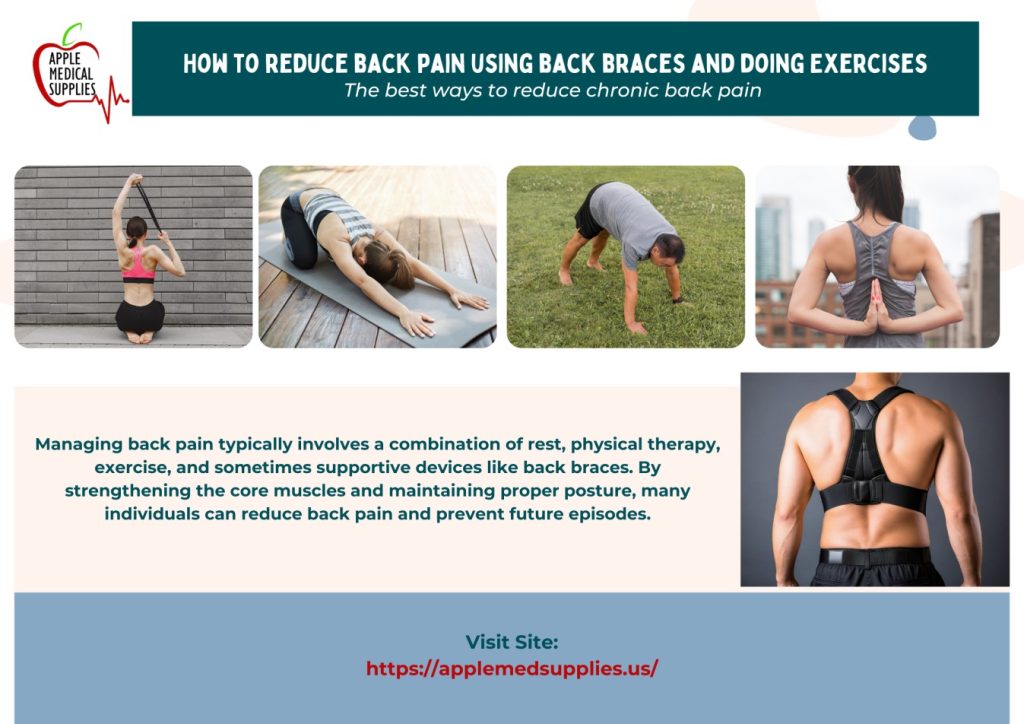Back pain is one of the most common health complaints, affecting people of all ages and lifestyles. Whether caused by poor posture, injury, or sitting for long hours, it can disrupt daily activities and diminish the quality of life. Luckily, there are effective ways to manage and reduce back pain, including the use of back braces and targeted exercises.
Understanding the Role of Back Braces
Back braces are supportive devices that help stabilize the spine and reduce pressure on the muscles and joints. They are commonly used for conditions like:
- Chronic lower back pain
- Muscle strain or sprains
- Postural issues
- Spinal injuries or surgeries
Wearing a back brace can provide immediate relief by limiting unnecessary movement, which in turn reduces muscle strain and helps prevent further injury. It also promotes proper spinal alignment, improving posture and taking pressure off the spine.
When to Use a Back Brace:
- During physical activity: For people engaging in heavy lifting, repetitive bending, or sports, a back brace can help reduce the risk of injury.
- Post-injury or surgery recovery: A back brace can provide extra support when your muscles are weak and healing.
- To improve posture: For individuals with poor posture habits, back braces can act as a reminder to maintain proper alignment.
However, it is essential to use back braces appropriately. Prolonged or incorrect use can lead to muscle weakness, as your body may become reliant on external support. It’s always best to consult a healthcare professional before starting to use a back brace regularly.
The Power of Exercise in Relieving Back Pain
While back braces offer temporary relief, exercise is the key to long-term pain management and prevention. Strengthening and stretching exercises target the muscles that support your spine, improving flexibility and reducing pressure on your back.
Key Benefits of Back Exercises:
- Strengthens core muscles
- Improves spinal stability
- Enhances flexibility and mobility
- Reduces inflammation and tension
- Prevents future injuries
5 Best Exercises for Reducing Back Pain
Here are five exercises that, when done correctly, can help reduce back pain and strengthen the muscles that support your spine:
- Pelvic Tilts
- Lie on your back with your knees bent and feet flat on the floor.
- Tighten your abdominal muscles, flattening your back against the floor.
- Hold for a few seconds and release.
- Repeat 10–15 times.
- Cat-Cow Stretch
- Start on your hands and knees, with your wrists aligned under your shoulders and knees under your hips.
- Arch your back towards the ceiling (Cat) and then slowly lower your belly towards the floor while lifting your chest (Cow).
- Repeat for 10–15 repetitions.
- Bridge Pose
- Lie on your back with knees bent and feet flat on the ground, hip-width apart.
- Lift your hips towards the ceiling, squeezing your glutes and engaging your core.
- Hold for a few seconds, then slowly lower back down.
- Repeat 10 times.
- Child’s Pose
- Start on your hands and knees, then sit back on your heels while reaching your arms forward.
- Rest your forehead on the floor and stretch out your spine.
- Hold for 30 seconds to 1 minute.
- Bird-Dog
- Begin on your hands and knees in a tabletop position.
- Extend your right arm forward and your left leg back, keeping your hips level.
- Hold for a few seconds, then switch sides.
- Repeat 10 times on each side.
Combining Back Braces and Exercises for Optimal Relief
Using a back brace in conjunction with a regular exercise routine offers a balanced approach to managing back pain. Here’s how they work together:
- Short-term support with long-term strength: Back braces provide immediate pain relief and support, while exercises help strengthen your muscles for lasting relief.
- Improved posture and alignment: Braces can help you maintain proper posture, especially during physical activity. Meanwhile, core-strengthening exercises improve your natural posture, reducing the need for a brace over time.
- Reduced muscle strain: The combination of back braces and exercises minimizes the strain on overworked muscles, allowing them to recover and preventing further injuries.
Tips for Safe and Effective Back Pain Management
- Consult a professional: Whether you’re considering a back brace or starting a new exercise routine, it’s crucial to consult a healthcare provider, especially if you have a chronic condition or previous injury.
- Stay consistent: Consistency is key to seeing long-term benefits from exercises. Even 10–15 minutes a day can make a significant difference.
- Listen to your body: If a particular movement or exercise increases pain, stop immediately and consult a professional for guidance.

